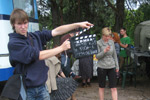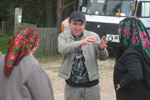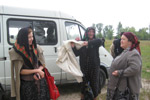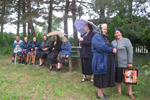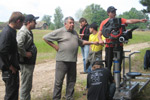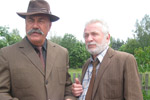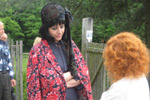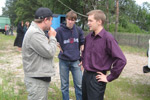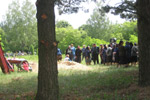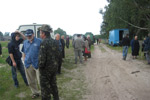 |
|||||||
Cinenews |
Crisis: A Visit of Ukrainian Film Shoot
June, 2008
During my five-week visit to Ukraine, the director Valeriy Yambursky invited me to attend the shoot of his debut feature narrative picture, “The Crisis”. The set was a cemetery near the picturesque village of Kolentsi, north of Kyiv. A small group consisting of the film crew and cast was dispatched in two vintage Soviet-era buses and two mini-buses of more recent Russian make [parading as Mercedeses] to the outskirts of the village on a grey warm day in early June. They were joined by a dozen local women hired as extras. The women were in a solemn mood, prepared for their part; the episode about to be shot was a funeral. They were visibly excited, after all, this was their “fifteen minutes of fame.” Their mature age, mid-fifties to mid-seventies, did little to dampen their enthusiasm.
Taking advantage of the presence of filmmakers from the capital one woman even brought along her a granddaughter and mobilized all her eloquence to persuade a third-tier member of the crew that her girl would make a brilliant actress – a new Natalia Naum. The man she accosted was obviously flattered by her attention. He relished his role of a casting director and feigned an earnest interest in the woman’s story while examining her young protégé, all dressed up for the occasion.
The general atmosphere on the set was that of creative chaos alternating with spells of paralysis caused by the weather - if it rained there would be filming, if the sun came out there would be no filming. There was only one camera, no fancy cranes, lighting or sound-recording equipment, no cutting-edge technology. It was a minimalist film set, so modest in fact that an outsider would not be able to say that a film was about to be shot there. It seemed that the only participants who showed excitement were the villagers. Others were either bored or had a matter-of-fact if not annoyed attitude – just another day of work.
Little was what it seemed. Even though the entire film was to be made in Ukrainian, all the actors without exception spoke Russian with each other during their trip from Kyiv to the location and on the set before the shoot. Among them were those whose mother tongue was Ukrainian. At least that was suggested by their peculiar version of Russian with a heavy Ukrainian inflection. They nevertheless went along with the flow, every now and then peppering their speech with Ukrainian words and phrases for comic effect, as if to share in the Soviet era idea that Ukrainian is a funny language suitable for yokels. When the director announced the presence of a “New Yorker” in their midst, some actors switched to Ukrainian when talking to me. Others would not, perhaps so as not to reveal that they could not speak it in a reasonably fluent manner or simply because they found no thrill in the sound of it. Such a lack of enthusiasm however was not considered serious enough a handicap to disqualify an actor from playing in a Ukrainian-language film. Finally I could see for myself why most Ukrainian language films of post-Soviet make I had seen, offered the stilted and artificial version of Ukrainian that was such a torture to hear.
And yet, first impressions are all too often misleading. We expect the final product to be released early next year, provided the Ukrainian Ministry of Culture delivers the financing it promised (which it almost never does on time). Valery Yambursky promised me that the UFCCU will be among the first to see his film. There is no reason to think otherwise. Good luck to him, to his crew and cast.
| The Soviet era vehicles as a backdrop for the shoot of “Crisis.” |
The director Valeriy Yambursky explains to three actors the subtleties of their parts. |
Dressing up in native country style, with a minimum of make-up and hearty laughter was all it took for the actresses to turn into three peasant women on the film set. |
The village women, dressed in their funeral best, waited patiently for the start of the shoot. |
Final instructions before the shoot from director Valeriy Yambursky (2nd from left) and director of photography Vitaliy Zymovets (3rd from left). |
| The film crew counts in its midst two actors who come very close to being called film stars: Mykhailo Holubovych (left) and Yevhen Papernyi (right). |
In a certain way the film was the Yambursky’s family undertaking: Iya Yamburska the director’s wife (both hail from the province of Odesa) got a part of her own to play in the film. |
The young aspiring actor Radyslav Ponomarenko (right) says that it is both a challenge and a joy to work with Valeriy Yambursky, who shows keen interest in every detail of the film and is always ready to help. |
The funeral scene was the first episode to be shot that day. With the extras all deployed at the village cemetery, the gaping grave recently dug, the all-too-real mannequin of the dead woman (the principal protagonist) in the coffin – everything was in place and ready. |
The prosaic view of the location could very well be a façade behind which the mystical event of the birth of a true masterpiece was about to take place. |
Text and photos by Yuri Shevchuk, editing by Michelle Viise.
